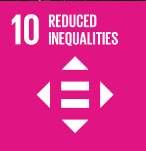SDG10 – Reduced Inequalities

New Vocabulary
- inequality
- discrimination
- marginalized
- migrants
- struggling
- race
- gender
- sexual orientation
- refugee
- voice
Practice the new vocabulary
Vocabulary for Reduced Inequalities (text version)
Match the words to their definitions:
Words:
- marginalized
- voice
- sexual orientation
- migrants
- race
- inequality
- refugee
- struggling
- discrimination
- gender
Definitions:
- the state of being unfair
- treating someone unfairly because they are different
- feeling unimportant or powerless in an unfair way
- people who move to another country to find work
- trying to fight hard for something
- a group of people defined by the colour of their skin and how they look
- the fact of being male, female or non-binary
- a person’s identity in relation to the gender or genders to which they are sexually attracted
- a person forced to leave their country because of political or religious reasons
- an opinion
Check your answer in footnote[1]
Activity source: Reduced Inequalities Vocabulary by Virginia McHardy, CC BY-NC 4.0
Reduced Inequalities
According to the United Nations Department of Economic and Social Affairs (n.d.) Goal 10 Infographic:
Inequality is a big problem that hurts people and slows down progress in the world. It makes it harder to reduce poverty and destroys people’s confidence and happiness. Inequality can lead to more crime, sickness, and damage to the environment.
COVID-19 made inequality worse, especially between countries. To fix this, we need to share resources fairly, invest in education and skills, protect people from discrimination, and help those who are marginalized.
Inequality affects people in many ways. Women and children often don’t get the healthcare they need. Migrants, refugees, and older people face discrimination and fewer opportunities. Many people experience unfair treatment because of their race, gender, religion, sexual orientation or disability.
To fight discrimination, we need to work together. Problems like poverty, climate change, and inequality affect everyone. Even rich countries have people struggling with poverty and discrimination. Reducing inequality is important to make the world better for everyone.
To reduce inequality, we need big changes. More effort is needed to end extreme poverty and hunger and to invest in healthcare, education, social protection, and good jobs, especially for young people, migrants, refugees, and other vulnerable groups.
Within countries, it is important to support fair social and economic growth. We can create equal opportunities by removing unfair laws, rules, and practices.
Between countries, we should make sure developing countries have a stronger voice in solving global problems, so solutions are fair and effective.
Governments can also help migrants by creating safe and well-planned policies for people who move to new places because of war, discrimination, poverty, or lack of opportunities.
Canadian Perspective
Goal 10, Reduced Inequalities (text version)
Reduced Inequality Within and Among Countries
Household Income Inequality
Household income inequality decreased by 11% from 2015 to 2020.
In 2020, the Gini coefficient[2] was 0.28, the lowest since 1989.
Median After-Tax Income
Median after-tax household income of Canadian families and unattached individuals rose 7% in 2020[3]. The largest annual increase 1976.
| Median hourly wage for full- and part-time employees 15 years and older | |
|---|---|
| Men | $28.00 |
| Women | $24.40 |
From 2015 to 2021, the gender wage gap narrowed by almost 5%.
Police-Reported Hate Crimes in 2021
There were 3,360 incidents of police-reported hate crimes in 2021, up 27% from 2020.
More than 1 in 2 police-reported hate crimes in 2021 targeted race or ethnicity. Among all police-reported hate crimes incidents, 884 targeted religion while 423 incidents targeted sexual orientation.
Community Spotlight: Accelerate Her Future
AHF envisions a Canada in which Black, Indigenous and racialized women are fully participating and thriving at all levels of leadership in their careers of choice.
Impact
There are more than 650 participants across all programs and a total of 1,180 volunteer hours.
Participant fellowship circle in 2022:
Access to networking increased 69% to 100% while mentorship access increased 68% to 95%.
Sources: Statistics Canada, Canadian Income Survey, 2020. Statistics Canada, Uniform Crime Reporting Survey, 2021. Statistics Canada, Labour Force Survey, 2022. Accelerate Her Future, 2022.
Source: Goal 10, Reduced Inequalities In Agenda 2030 Sustainable Development Goals Report, 2022 by Statistics Canada, used under Open License
Discussion Questions
Use the new vocabulary words in these discussion questions. Ask and answer in partners or small groups:
- What does inequality mean? Can you think of examples of inequality in your community or country?
- What is discrimination? How can we stop discrimination in schools, workplaces, or society?
- Who are marginalized groups in society? What can we do to help them feel included?
- Why do people become migrants? What challenges do migrants face when they move to a new country?
- How can we support people who are struggling because of poverty or lack of opportunities?
- How does race affect equality? What can we do to ensure people of all races are treated fairly?
- Why is gender equality important? Can you think of ways to support women and girls in your community?
- How can we create a society where people of all sexual orientations feel safe and accepted?
- What is the difference between a migrant and a refugee? How can countries help refugees who are fleeing danger?
- Why is it important for everyone to have a voice in decisions that affect their lives?
Watch the video:
Watch Goal 10: Reduced Inequalities (2 min) on YouTube
Video source: UNStats. (2022, July 7). Goal 10 – Reduced inequalities [Video]. YouTube. https://www.youtube.com/watch?v=Dq0iypmVztk
Reduced Inequalities Video Quiz (text version)
- True or false? Covid 19 made the income gap between countries grow for the first time in many years.
- Use the numbers provided to complete the sentence:
Numbers: 2021, 2017, 6,000
Sentence: Almost [Blank A] expats passed away in [Blank B]. Not since [Blank C] had migrants had so many workers die while on the job. - How many refugees fled their countries worldwide in 2021?
- 216
- 100,000
- 311
- 311 per 100,000 people
- True or false? The number of refugees around the world decreased by 44% during 2015 and 2021.
- Discrimination has happened to _______[Blank A] of the global population.
- 5
- 20%
- 15%
- a lot of
Check your answers in footnote[5]
Activity source: Reduced Inequalities video quiz by Virginia McHardy, CC BY-NC 4.0
Key Targets for SDG 10
- 10.1 By 2030, progressively achieve and sustain income growth of the bottom 40 per cent of the population at a rate higher than the national average.
- 10.2 By 2030, empower and promote the social, economic and political inclusion of all, irrespective of age, sex, disability, race, ethnicity, origin, religion or economic or other status.
- 10.3 Ensure equal opportunity and reduce inequalities of outcome, including by eliminating discriminatory laws, policies and practices and promoting appropriate legislation, policies and action in this regard.
- 10.4 Adopt policies, especially fiscal, wage and social protection policies, and progressively achieve greater equality.
- 10.5 Improve the regulation and monitoring of global financial markets and institutions and strengthen the implementation of such regulations.
- 10.6 Ensure enhanced representation and voice for developing countries in decision-making in global international economic and financial institutions in order to deliver more effective, credible, accountable and legitimate institutions.
- 10.7 Facilitate orderly, safe, regular and responsible migration and mobility of people, including through the implementation of planned and well-managed migration policies.
- 10.a Implement the principle of special and differential treatment for developing countries, in particular least developed countries, in accordance with World Trade Organization agreements.
- 10.b Encourage official development assistance and financial flows, including foreign direct investment, to States where the need is greatest, in particular least developed countries, African countries, small island developing States and landlocked developing countries, in accordance with their national plans and programmes.
- 10.c By 2030, reduce to less than 3 per cent the transaction costs of migrant remittances and eliminate remittance corridors with costs higher than 5 per cent.
Source: United Nations Department of Economic and Social Affairs. (n.d.). Goal 10 [Infographic]. Sustainable Development Goals. https://sdgs.un.org/goals/goal10

Homework/Assignment:
Write a reflection on one of the following topics:
- What is inequality, and why is it a problem?
- How can education reduce inequality?
- The role of gender equality in reducing inequality.
- Challenges faced by migrants or refugees and how to help them.
- Ideas to stop discrimination in your community or country.
You can read more about Goal #10 in The Sustainable Development Goals Report 2022 from the UN.:
For instructors, please visit York University’s The SDGs-in-the-Classroom Toolkit for lesson ideas
Attribution & References
Except where otherwise noted, this page is created by Virginia McHardy, CC BY-NC 4.0
References
United Nations Department of Economic and Social Affairs. (n.d.). Goal 10 [Infographic]. Sustainable Development Goals. https://sdgs.un.org/goals/goal10
- 1. inequality, 2. discrimination, 3. marginalized, 4. migrants, 5. struggling, 6. race, 7. gender, 8. sexual orientation, 9. refugee, 10. voice ↵
- Based on adjusted household after-tax income. The Gini coefficient is a number between zero and one that measures the relative degree of inequality in the distribution of income. The higher the coefficient, the higher the inequality of the distribution. ↵
- The increase in income observed in 2020 was largely due to government transfers for Covid-19 relief programs. ↵
- Wages based on median hourly wages for full-time and part-time employees aged 15 years and older. ↵
- 1. True. 2. a) 6,000, b) 2021, c) 2017. 3. d) 311 per 100,000 people. 4. False. 5. Blank A = 20% ↵
the state of being unfair
treating someone unfairly because they are different
feeling unimportant or powerless in an unfair way
people who move to another country to find work
a group of people defined by the colour of their skin and how they look
the fact of being male, female or non-binary
a person's identity in relation to the gender or genders to which they are sexually attracted
trying to fight hard for something
a person forced to leave their country because of political or religious reasons
an opinion

